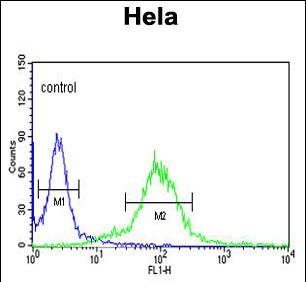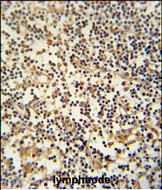


| WB | 1/1000 | Human,Mouse,Rat |
| IF | 咨询技术 | Human,Mouse,Rat |
| IHC | 1/100-1/500 | Human,Mouse,Rat |
| ICC | 技术咨询 | Human,Mouse,Rat |
| FCM | 1/10-1/50 | Human,Mouse,Rat |
| Elisa | 咨询技术 | Human,Mouse,Rat |
| Aliases | Mastermind-like protein 3, Mam-3, MAML3 (HGNC:16272) |
| Entrez GeneID | 55534 |
| WB Predicted band size | 122.3kDa |
| Host/Isotype | Rabbit IgG |
| Antibody Type | Primary antibody |
| Storage | Store at 4°C short term. Aliquot and store at -20°C long term. Avoid freeze/thaw cycles. |
| Species Reactivity | Human |
| Immunogen | This MAML3 antibody is generated from rabbits immunized with a KLH conjugated synthetic peptide between 640-665 amino acids from the C-terminal region of human MAML3. |
| Formulation | Purified antibody in PBS with 0.05% sodium azide,1%BSA and 50% glycerol.prepared by Saturated Ammonium Sulfate (SAS) . |
+ +
以下是三篇关于MAML3抗体的参考文献及其摘要概括:
1. **"Recurrent fusion gene MAML3 in mucinous liposarcoma: insights from molecular characterization"**
- **作者**: Antonescu, C.R., et al.
- **摘要**: 该研究通过免疫组化(IHC)和荧光原位杂交(FISH)技术,利用MAML3特异性抗体检测黏液样脂肪肉瘤中的MAML3基因重排,揭示了MAML3与其他基因(如WWTR1)的融合在肿瘤发生中的作用。
2. **"Mastermind-like 3 (MAML3) drives Notch-dependent transcriptional activation in cancer"**
- **作者**: Lin, S., et al.
- **摘要**: 研究阐明了MAML3作为Notch信号通路共激活因子的分子机制,通过Western blot和染色质免疫沉淀(ChIP)实验,使用MAML3抗体证实其在多种癌细胞中调控下游靶基因(如HES1)的表达。
3. **"MAML3 promotes metabolic reprogramming in hepatocellular carcinoma through Hedgehog signaling"**
- **作者**: Wang, Y., et al.
- **摘要**: 该文献报道了MAML3通过Hedgehog信号通路促进肝癌细胞的代谢重编程,利用MAML3抗体进行免疫共沉淀(Co-IP)实验,揭示了其与GLI转录因子的相互作用及对糖酵解关键酶的调控。
4. **"Alterations of MAML3 in thyroid carcinoma correlate with tumor progression"**
- **作者**: Jung, S.H., et al.
- **摘要**: 研究分析了甲状腺癌中MAML3的异常表达,通过免疫组化(IHC)和qRT-PCR技术结合MAML3抗体,发现MAML3过表达与肿瘤侵袭性和患者预后不良显著相关。
以上文献均涉及MAML3抗体在分子机制或临床病理研究中的应用,涵盖肿瘤发生、信号通路及代谢调控等领域。
The MAML3 (Mastermind-like protein 3) antibody is a research tool designed to detect the MAML3 protein, a member of the Mastermind-like family of transcriptional coactivators. MAML3 plays a critical role in the Notch signaling pathway, where it binds to the intracellular domain of Notch receptors and the CSL transcription factor (CBF1/RBP-Jκ, Su(H), Lag-1) to activate downstream target genes. Unlike MAML1 and MAML2. MAML3 exhibits distinct functional roles, including involvement in alternative signaling pathways such as Hedgehog and Wnt, and has been implicated in chromatin modification through interactions with histone acetyltransferases (e.g., p300).
Research highlights MAML3's association with tumorigenesis, particularly in T-cell leukemia, breast cancer, and lung adenocarcinoma, where its dysregulation (e.g., gene fusions or overexpression) drives oncogenic transcription programs. The MAML3 antibody is widely used in techniques like Western blotting, immunohistochemistry, and immunofluorescence to study its expression, localization, and interaction partners in cellular and tissue contexts. Its development has advanced understanding of MAML3's dual roles in Notch-dependent and -independent pathways, as well as its impact on stem cell differentiation, tissue development, and cancer progression. Validated antibodies are essential for elucidating its mechanistic contributions to disease and potential therapeutic targeting.
×